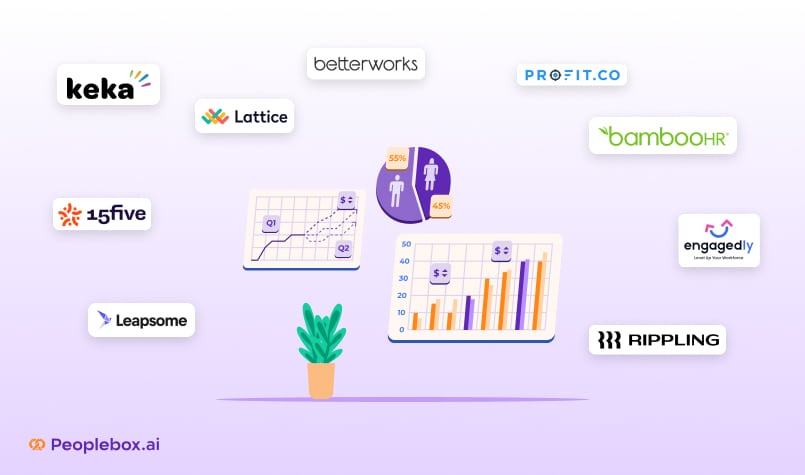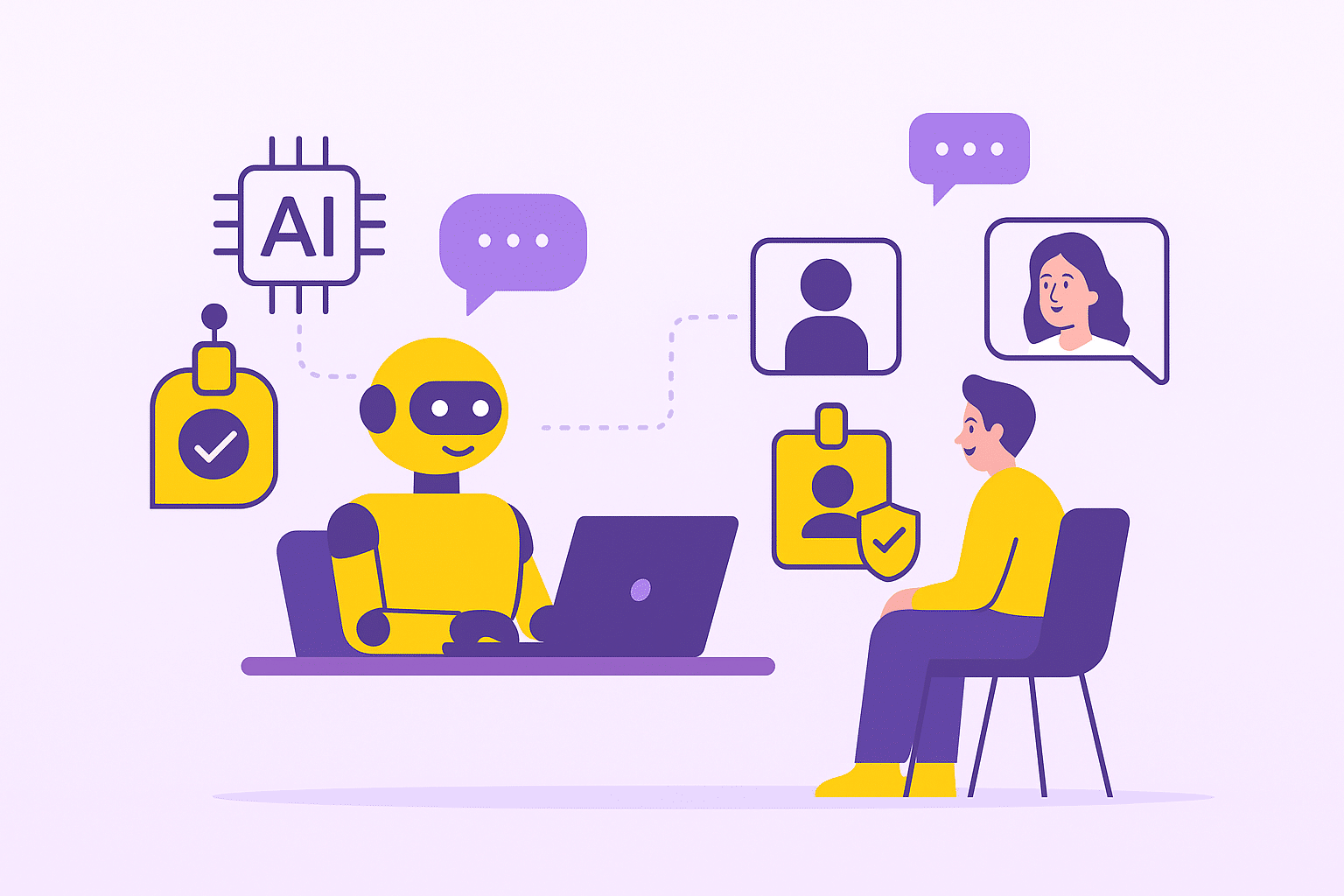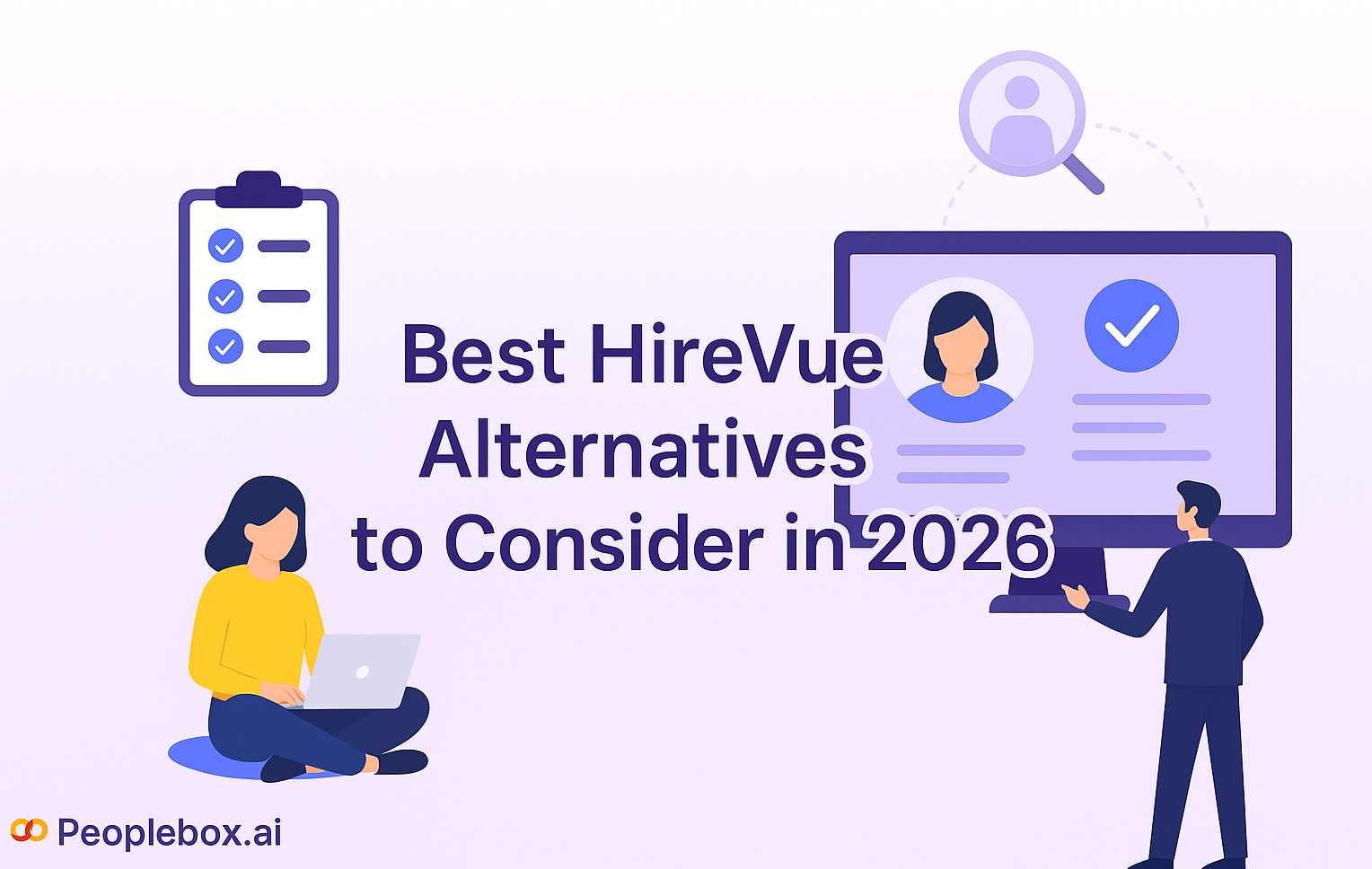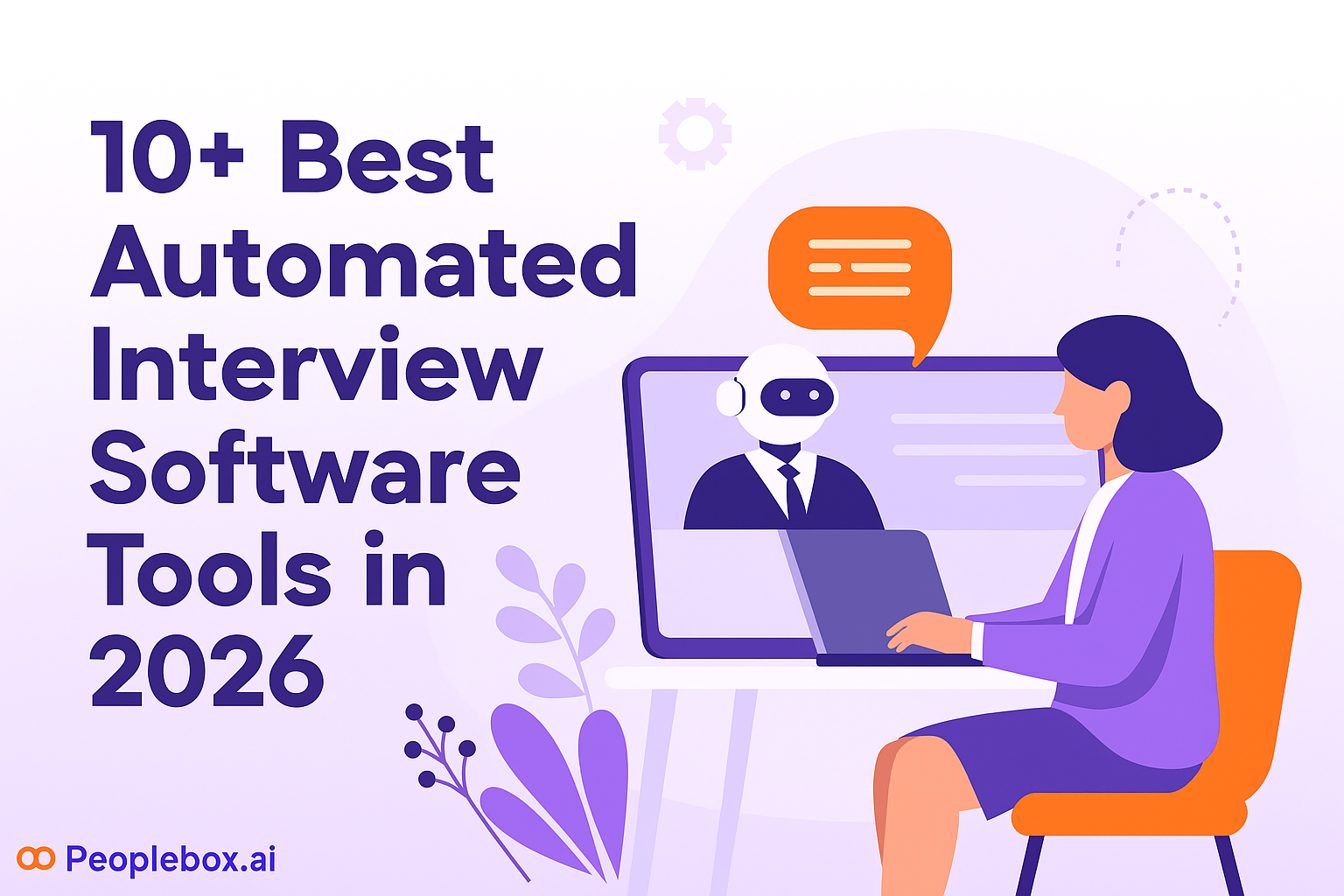An employee’s growth isn’t just about hitting targets it’s about how they’re evaluated and supported in their workplace. Performance appraisal software isn’t just a place to store ratings and reviews; it creates a fair, transparent way to measure performance, eliminate bias, and open up real conversations about career development.
The right software can completely change how businesses nurture talent, but with so many options out there, picking the best one can feel overwhelming.
That’s why we’ve put together this guide to help you navigate the top performance appraisal software for 2025, break down their key features, and find the one that best supports your team’s growth.
Top Performance Appraisal Software Solutions for 2025
Here is a list of the best performance appraisal software solutions for 2025:
- Peoplebox.ai
- BambooHR
- Lattice
- 15Five
- Engagedly
- Zoho People
- Workday
- PerformYard
- Culture Amp
- Trakstar Performance Management
- AssessTEAM
- Leapsome
- Rippling
- Keka
- Betterworks
- Profit co.
1. Peoplebox.ai
Peoplebox.ai is a performance appraisal software that helps managers move beyond just performance ratings; it creates a space for real, constructive conversations that drive employee growth. By aligning personal goals with company objectives, it ensures that performance reviews aren’t just a routine task but a tool for professional development.
Key Features:
- 360-Degree Feedback: Get a well-rounded view by collecting insights from managers, peers, and direct reports.
- Goal Tracking & OKR Management: Keep teams aligned by setting, tracking, and measuring meaningful objectives.
- Performance Review Automation: Take the hassle out of appraisals with automated review cycles.
- AI-Driven Insights for Employee Growth: Leverage AI to identify strengths, areas for improvement, and career growth opportunities.
- Seamless Integration with Slack & Microsoft Teams: Keep performance discussions ongoing by integrating directly into everyday workflow tools.
Interested to see the software in action? Explore the guided demo of Peoplebox.ai.
Pricing:
Starts at $7/user/month
2. BambooHR
Performance reviews shouldn’t feel like a checklist; they should be a chance to support employee growth and align individual efforts with company goals. BambooHR makes this process smoother by providing an intuitive platform that helps managers and HR teams conduct meaningful, structured evaluations without the administrative hassle.
Key Features:
- Customizable Performance Reviews: Design reviews that fit your company’s culture and focus on what truly matters.
- Employee Self-Assessments: Empower employees to reflect on their progress and take ownership of their development.
- Goal Alignment Tools: Set clear, measurable goals that align individual contributions with business priorities.
- Automated Review Reminders: Keep evaluations on track with timely notifications and scheduled reminders.
- Seamless HR & Payroll Integration: Connects effortlessly with HR and payroll systems for a streamlined experience.
Pricing:
Custom pricing based on business needs.
3. Lattice
Great performance management isn’t just about annual reviews, it’s about fostering continuous growth, engagement, and alignment with company goals. Lattice helps businesses create a culture of feedback and development with data-driven insights and intuitive tools.
Key Features:
- Continuous Feedback System: Enables real-time conversations between employees and managers, ensuring ongoing improvement and accountability.
- Employee Engagement Surveys: Gathers insights on employee sentiment to help HR teams build stronger, more engaged teams.
- Customizable Career Development Plans: Aligns individual growth paths with company objectives to support long-term employee success.
- OKR and Goal Tracking: Ensures employees stay focused on strategic objectives by tracking progress and performance milestones.
- AI-Powered HR Analytics: Uses AI-driven insights to help HR teams make smarter decisions about workforce planning and performance management.
Pricing:
Starts at $11/user/month
4. 15Five
Great performance isn’t built in a single review cycle; it’s nurtured through ongoing conversations and meaningful feedback. 15Five helps companies foster a culture of continuous improvement with structured check-ins and real-time insights.
Key Features:
- Weekly Performance Check-Ins: Encourages employees to share progress, roadblocks, and wins regularly, keeping communication open.
- Peer and Manager Feedback: Ensures well-rounded evaluations by gathering input from colleagues and leadership.
- Customizable Review Templates: Adapts to company-specific performance criteria, ensuring appraisals align with business values.
- AI-Driven Coaching Insights: Provides managers with data-backed coaching recommendations to support employee growth.
- Mobile-Friendly Performance Tracking: Empowers remote and on-the-go employees to stay engaged and track their progress seamlessly.
Pricing:
Starts at $9/user/month
5. Engagedly
Performance management isn’t just about evaluations, it’s about fostering engagement, motivation, and continuous growth. Engagedly bridges performance management with employee engagement tools to create a high-performance culture.
Key Features:
- 360-Degree Feedback: Provides a well-rounded view of employee performance by collecting insights from peers, managers, and self-assessments.
- Recognition and Rewards: Encourages a culture of appreciation by enabling employees and managers to recognize and reward achievements.
- AI-Driven Performance Insights: Uses AI to analyze performance trends and offer personalized growth recommendations.
- Learning Management System (LMS) Integration: Connects with learning platforms to support continuous employee development.
- Employee Goal-Setting Tools: Helps align individual objectives with company goals for measurable growth.
Pricing:
Starts at $5,000/year
6. Zoho People
Zoho People is a cloud-based performance appraisal software designed to streamline employee evaluations while offering powerful HR and performance tracking tools. Its flexible and automated features make it a great fit for businesses of all sizes.
Key Features:
- Customizable Performance Appraisals: Tailor performance reviews to fit organizational goals and evaluation criteria.
- Self and Peer Reviews: Encourage a 360-degree approach to feedback by integrating self-assessments and peer evaluations.
- AI-Powered HR Insights: Leverage AI-driven analytics to identify workforce trends and predict employee performance.
- Automated Performance Review Cycles: Reduce administrative workload with scheduled, automated appraisal workflows.
- Workforce Analytics and Reporting: Generate data-driven reports to track employee progress and make informed HR decisions.
Pricing:
Starts at $1.50/user/month
7. Workday
Workday is a leading human capital management software that offers a robust performance appraisal module tailored for enterprises. It provides AI-powered insights and customizable workflows to help organizations manage employee performance effectively.
Key Features:
- AI-Driven Performance Tracking: Leverages machine learning to analyze performance trends and offer predictive insights.
- Employee Development & Succession Planning: Identifies high-potential employees and creates structured career growth paths.
- Continuous Feedback & Goal Alignment: Encourages real-time feedback and ensures employee goals align with company objectives.
- Custom Workflows for Different Industries: Provides industry-specific templates and customization options for tailored evaluations.
- Compliance & Reporting Features: Maintains regulatory compliance and generates detailed performance reports for strategic decision-making.
Pricing:
Custom pricing based on enterprise requirements.
8. PerformYard
PerformYard is a flexible and scalable employee appraisal software designed for businesses that require customizable performance reviews. It streamlines performance tracking with data-driven insights and seamless HR integrations.
Key Features:
- Custom Review Cycles: Allows businesses to create tailored appraisal processes to match company-specific needs.
- Goal Tracking & Analytics: Helps organizations set, monitor, and evaluate employee performance goals.
- KPI-Based Performance Monitoring: Tracks productivity using key performance indicators to measure employee effectiveness.
- Seamless HRIS Integrations: Ensures smooth data synchronization between performance management and existing HR systems.
- Employee Performance Dashboards: Provides a clear visual representation of individual and team performance metrics.
Pricing:
Starts at $5/user/month
9. Culture Amp
Culture Amp is a data-driven performance appraisal software designed to enhance employee development and engagement. It empowers organizations with real-time feedback, AI-driven insights, and structured growth plans to foster a high-performance workplace.
Key Features:
- Real-Time Feedback & Performance Tracking: Enables continuous feedback between employees and managers to promote accountability and development.
- Employee Development Planning: Supports structured career growth by aligning employee aspirations with company goals.
- AI-Powered Engagement Insights: Leverages artificial intelligence to analyze employee sentiment, engagement trends, and performance patterns.
- Goal Alignment Features: Helps employees stay on track with company objectives by monitoring progress and key milestones.
- Seamless HR System Integration: Connects effortlessly with existing HR management tools for a streamlined employee experience.
Pricing:
Custom pricing available upon request.
10. Trakstar
Trakstar helps organizations track employee progress through goal-based performance evaluations, providing actionable insights to drive professional growth and alignment with business objectives.
Key Features:
- Customizable Appraisal Templates: Flexible review templates tailored to company-specific evaluation criteria.
- Goal Tracking & Progression Assessment: Enables employees and HR managers to set, monitor, and measure goals for individual and team success.
- 360-Degree Feedback: Collects input from peers, supervisors, and subordinates for a well-rounded performance review.
- AI-Driven Performance Insights: Leverages AI to identify top talent and pinpoint areas for improvement.
- Employee Coaching & Training Tools: Provides built-in coaching resources and personalized development plans to support employee growth.
Pricing:
Custom pricing based on enterprise needs.
11. AssessTEAM
AssessTEAM is a cloud-based, multilingual performance management tool that enables businesses to evaluate employee competencies and measure workforce productivity effectively.
Key Features:
- Real-Time Performance Tracking: Continuously monitors employee contributions, providing instant feedback for timely improvements.
- Project Profitability Analysis: Links performance metrics to project outcomes, helping businesses assess workforce efficiency.
- Customizable Evaluation Templates: Allows organizations to design tailored performance reviews based on company goals and employee roles.
- AI-Powered Workforce Insights: Utilizes predictive analytics to identify performance trends and areas needing improvement.
- Multilingual Interface: Supports multiple languages, making it ideal for global teams.
Pricing:
Starts at $5/user/month.
12.Leapsome
Leapsome is a performance appraisal software that integrates performance management, employee engagement, and learning tools to drive a high-performance culture. It helps organizations improve workforce alignment and foster professional growth.
Key Features:
- 360-Degree Feedback: Collects input from peers, managers, and self-assessments for a well-rounded evaluation.
- Goal & OKR Management: Enables businesses to set, track, and align employee objectives with company goals.
- Customizable Performance Reviews: Provides structured templates for continuous and transparent assessments.
- Employee Development Plans: Identifies skill gaps and creates personalized learning paths to support career growth.
- Seamless Integrations: Connects with HR and communication tools like Slack, Microsoft Teams, and HRIS.
Pricing:
Starts at $8/user/month.
13.Rippling
Rippling is a human capital management software that integrates performance appraisal tools with HR, payroll, and IT functions. It automates workforce management while ensuring seamless performance evaluations.
Key Features:
- Automated Performance Reviews: Streamlines the review process with automated scheduling and reminders.
- Real-Time Feedback & Surveys: Facilitates ongoing feedback to drive continuous employee improvement.
- Goal Setting & Progress Tracking: Helps employees and managers align individual and company objectives.
- Comprehensive HR Integration: Connects performance management with payroll, benefits, and IT provisioning for a unified system.
- AI-Driven Workforce Insights: Analyzes performance trends and employee productivity with predictive analytics.
Pricing:
Starts at $8/user/month (varies based on selected features).
14.Keka
Keka is an HR and performance appraisal software designed for small to mid-sized businesses, offering a seamless approach to payroll, attendance, and employee performance management.
Key Features:
- Customizable Performance Appraisals: Set up tailored review cycles to match company-specific needs.
- Self & Peer Reviews: Encourages multi-level feedback for a fair and well-rounded evaluation process.
- AI-Powered HR Insights: Uses AI-driven analytics to identify top performers and areas for improvement.
- Automated Review Cycles: Streamlines performance appraisals with scheduled workflows and reminders.
- Employee Development & Training: Provides personalized learning recommendations based on performance trends.
Pricing:
Starts at $5/user/month.
15.Betterworks
Betterworks is a performance appraisal software designed for continuous performance management, helping organizations align employees with strategic business goals. By integrating goal-setting, feedback, and analytics, it enhances engagement and productivity.
Key Features:
- OKR & Goal Management: Aligns individual and team objectives with company-wide priorities for better performance tracking.
- Continuous Feedback System: Enables real-time coaching and ongoing performance conversations.
- 360-Degree Performance Reviews: Facilitates well-rounded evaluations with input from managers, peers, and self-assessments.
- AI-Powered Analytics: Delivers insights into employee engagement, productivity, and growth opportunities.
- Seamless Integrations: Connects with HRIS, communication, and productivity tools like Slack and Microsoft Teams.
Pricing:
Starts at $7/user/month.
16.Profit.co
Profit.co is a performance appraisal software built around OKR (Objectives and Key Results) management, helping organizations track, align, and optimize employee performance with business goals.
Key Features:
- OKR & KPI Tracking: Enables organizations to set, monitor, and refine performance objectives with measurable key results.
- 360-Degree Feedback: Collects feedback from multiple sources for a well-rounded performance evaluation.
- Performance Reviews & Check-ins: Supports structured performance evaluations with regular check-ins and review cycles.
- AI-Powered Insights: Provides real-time analytics on employee engagement, productivity trends, and goal progress.
- Seamless Integrations: Works with HR and collaboration tools like Slack, Microsoft Teams, and HRIS.
Pricing:
Starts at $7/user/month.
Performance Appraisal Software Comparison Table
Choosing the right performance appraisal software is essential for businesses looking to streamline performance reviews, enhance employee engagement, and align individual goals with company objectives.
The table below compares the top performance appraisal software solutions for 2025, highlighting their core features to help you make an informed decision.
| Software | Description | Key Features |
| Peoplebox.ai | A goal-oriented performance management software designed for fast-growing companies, aligning teams with business objectives. | OKR and goal management, Performance reviews, Real-time feedback |
| Keka HR | A user-friendly HR solution for payroll, attendance, and performance tracking, ideal for small to mid-sized businesses. | Payroll management, Employee engagement, Time tracking |
| Profit.co | An OKR-driven performance management tool that helps businesses track and optimize goal achievement. | OKR and KPI tracking, 360-degree feedback, Performance analytics |
| BambooHR | A HR management platform simplifying hiring, onboarding, and employee evaluations for SMBs. | Employee database, Time-off tracking, Reporting & analytics |
| Engagedly | A performance management and engagement platform designed to drive workforce productivity. | 360-degree feedback, Goal alignment, Learning & development |
| Lattice | A comprehensive performance management tool focused on employee growth and engagement. | Continuous feedback, Employee engagement surveys, Career development plans |
| 15Five | A continuous performance management software with structured feedback and check-ins. | Weekly check-ins, Peer and manager feedback, AI-driven coaching insights |
| Zoho People | A scalable cloud-based HR and performance appraisal tool for businesses of all sizes. | Customizable appraisals, Self & peer reviews, AI-powered insights |
| Workday | An enterprise-level HCM platform with AI-powered performance tracking and workforce planning. | AI-driven tracking, Employee development, Goal alignment |
| PerformYard | A customizable employee appraisal solution with flexible review cycles and analytics. | Custom review cycles, KPI-based monitoring, Performance dashboards |
| Culture Amp | A data-driven employee development platform focused on engagement and performance tracking. | Real-time feedback, Employee development planning, AI-powered insights |
| Trakstar Performance | A goal-based performance evaluation tool helping organizations assess and track employee progress. | Custom appraisal templates, Goal tracking, 360-degree feedback |
| AssessTEAM | A multilingual performance management tool for workforce productivity and competency evaluation. | Real-time tracking, Project profitability analysis, AI-powered insights |
| Leapsome | A holistic employee development and performance management platform integrating feedback, learning, and goal tracking. | Continuous feedback, Learning & development, Goal alignment |
| Rippling | A unified HR & IT platform that automates performance management, payroll, and compliance. | Automated reviews, HR & IT integration, Compliance management |
| Betterworks | A goal-focused performance management tool promoting continuous employee growth and alignment. | OKR tracking, Employee check-ins, AI-powered insights |
Why Use Performance Appraisal Software?
Performance appraisal software streamlines employee evaluations by automating feedback collection, tracking goals, and providing data-driven insights. The key benefits include:
- Increased Efficiency – Automates workflows, reducing administrative workload.
- Objective Evaluations – Uses analytics to ensure fair and unbiased appraisals.
- Enhanced Employee Engagement – Encourages continuous feedback and professional development.
- Customizable Review Processes – Adapts appraisal frameworks to fit business needs.
- Seamless HR Integration – Syncs with HR, payroll, and workforce planning tools.
- AI-Powered Insights – Leverages artificial intelligence to analyze performance trends.
- Scalability – Supports businesses of all sizes with flexible appraisal cycles.
- Mobile Accessibility – Enables remote performance tracking via mobile-friendly platforms.
How to Choose the Right Performance Appraisal Software?
When selecting the best performance appraisal software, consider these key factors:
- Company Size & Needs – Ensure the software aligns with your organizational goals.
- Integration Capabilities – Look for compatibility with your existing HR and payroll systems.
- Customization Options – Choose a solution that allows you to tailor appraisals to specific competencies.
- User-Friendly Interface – A simple and intuitive platform improves adoption rates.
- AI & Automation – Smart analytics enhance decision-making and performance tracking.
- Scalability – Ensure the tool grows with your workforce.
- Mobile Accessibility – Essential for remote and hybrid teams.
Best Practices for Implementing Performance Appraisal Software
Implementing performance appraisal software effectively requires a strategic approach to maximize its impact on employee development and business growth. Here are some essential best practices:
- Define Clear Objectives – Establish what you aim to achieve with the software, such as improving employee engagement, streamlining performance reviews, or enhancing goal alignment.
- Get Leadership Buy-In – Ensure senior management supports the adoption of the software to drive company-wide acceptance.
- Train Employees & Managers – Provide comprehensive training to ensure smooth onboarding and effective utilization of all software features.
- Integrate with Existing Systems – Choose software that seamlessly connects with your HR, payroll, and collaboration tools for a unified workflow.
- Monitor & Optimize – Regularly assess software performance and gather user feedback to refine processes and improve effectiveness.
These best practices help organizations successfully implement performance appraisal software, ensuring it enhances productivity, engagement, and decision-making.
Future of Performance Appraisal Software
The performance management landscape is evolving, driven by technology and changing workplace expectations. Here’s what to expect:
- AI & Automation – AI will analyze performance trends, provide predictive insights, and automate review cycles.
- Real-Time Feedback – Traditional annual reviews will phase out in favor of continuous performance tracking.
- Personalized Employee Development – Advanced analytics will enable tailored career growth plans.
- Deeper HR & HCM Integration – Appraisal tools will seamlessly connect with HR and workforce management platforms.
- Employee-Centric Approach – Future systems will prioritize well-being, engagement, and holistic performance metrics.
Companies that invest in modern performance appraisal software will gain a competitive advantage by boosting employee productivity, retention, and overall success.
What Makes Peoplebox.ai the Best Performance Appraisal Software?
Peoplebox.ai is a leading employee appraisal solution that helps businesses align individual goals with overall company objectives. Here’s why it stands out:
- Seamless OKR & Goal Management – Enables organizations to track progress through structured OKRs (Objectives and Key Results) while aligning them with strategic goals.
- 360-Degree Feedback – Fosters a culture of transparency by collecting performance insights from peers, managers, and self-assessments.
- Automated Performance Reviews – Simplifies the evaluation process with automated workflows, reducing administrative overhead.
- AI-Driven Insights – Uses artificial intelligence to offer data-backed recommendations for employee growth, skill development, and career progression.
- Integration with Productivity Tools – Works seamlessly with platforms like Slack and Microsoft Teams to enhance engagement and accessibility.
- Customizable Review Cycles – Provides flexibility to tailor appraisal processes according to business needs and employee roles.
With these features, Peoplebox.ai empowers organizations to build a high-performance workforce with data-driven decision-making.
Bottom line
Performance appraisal software is a critical tool for businesses looking to enhance employee productivity, engagement, and alignment with company goals. By integrating with human capital management software, organizations can create a streamlined and transparent evaluation process.
Whether you’re a small startup or an enterprise, choosing the right performance management tool can optimize workforce efficiency and drive long-term business success.
Looking for expert recommendations? Sign up for a demo today!






